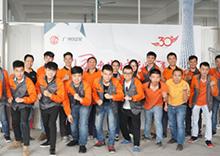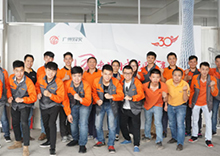tungsten argon arc welding (two)
Tungsten arc argon arc welding is a rich master, unlike the manual welding of the coarse man, wherever can be well adapted. In order to obtain good welding effect in TIG welding, the preparation before welding is essential.
First, cleaning before welding
The argon tungsten arc welding requires high quality of the material surface. Before welding, we must strictly clean up and remove the oil pollution, moisture, dust and oxide film at least 20mm within the surface of the welding wire and workpiece and the sides of the groove. Otherwise, the stability of the arc will be affected in the welding process, and the formation of the weld will be deteriorated, and the defects, such as air hole, inclusion and non fusion, will be caused.
Commonly used cleaning methods:
1. remove oil and dust
Using organic solvents, scrubbing of gasoline, acetone, trichloroethylene, carbon tetrachloride, and so on
2. scavenging oxide film:
A. mechanical cleaning
It is usually made of stainless steel wire or copper wire (brush) to remove the groove and its oxide film on both sides. In general, it is used only for large size, long production cycle or local contamination after chemical cleaning.
B. chemical cleaning
This method has good cleaning effect on nonferrous metals, such as aluminum, magnesium, titanium and its alloys.
Note: the material of aluminum and its alloy is soft. It is not suitable for sand blasting.
After cleaning, it is generally welded within 24 hours. If the contamination or time is too long in the storage process, it must be recleaned before welding.
二.Selection of welding parameters
1. Welding current
TIG welding of welding current usually take the slow rise and slow drop, with less arc ignition arc current in welding arc welding, and then automatically according to the time set by the current rate to be used to improve the welding current value, this is mainly for welding travel to provide a buffer time. For observation of the initial state after arc ignition (such as whether the arc burning in the welding line). At the end of welding, the welding current according to the time set by the rate of decline, finally extinguished, this is mainly to sag beneath the arc weld pool has a metal backfill process, prevent high current arc crater formation in the weld, while in a closed shape weld, the weld joints will not be excessive melted
It depends on the type and specification of the tungsten pole. When the current is too small, it is difficult to control the forming of the welding path, and it is easy to form unfusing and unwelded defects. At the same time, the low production efficiency will waste argon when the current is too small. When the current is too large, it is easy to form a bump and burn through defects. When the temperature of the pool is too high, the edge of the bite and the forming of the welding path will appear. The current size should be appropriate. According to experience, the current is generally 30-55 times the diameter of the tungsten electrode. The AC power supply selects the lower limit and the DC is directly connected to the upper limit. When the tungsten diameter is less than 3mm, the 5-10A value is subtracted from the calculated value. When the tungsten diameter is larger than 4mm, the calculated value plus 10-15A. At the same time, it is also important to note that the welding current can not be greater than the permissible current of the tungsten pole.
2. Arc voltage
TIG welding is mostly based on the length of the arc as a standard parameter. When the arc length increases, the arc voltage increases, and the melting width and the area of the arc heating increase. The length of the arc is usually made of short arc welding (1-3mm without welding wire and 3-6mm with wire) according to the size of the current.
3. Welding speed
The welding speed is easy to produce the defects such as non fusion, gas hole and other defects, and the welding speed is too slow to produce the defects of the bite and penetration. Generally, TIG welding can maintain a more stable arc shape than other welding methods at the welding speed of 5~50cm/min.
4. Protection of gas flow
In order to reduce the cost, the gas flow is minimized under the premise that the protective effect is good. The flow is too small, air spurting stiffness, light weak, easily disturbed by the airflow, protective effect, and the arc can burn stably, welding can be seen on the surface of the oxide drift of molten pool and weld dark without light. The flow rate is too large, which will not only waste the protection gas, but also cause the weld cooling to be too fast, which is not conducive to weld formation, and at the same time, it is easy to form turbulent flow and get involved in the air, which will destroy the protection effect. The gas flow rate of Q is mainly determined by the diameter of nozzle and the type of protective gas. It is also related to the properties of welding metal, welding speed, groove form, tungsten extension length and arc length. The manual welding can be calculated by the empirical formula Q= (0.18-1.2) D. The D is the nozzle diameter, the unit is mm, and the Q unit is L/mm. When D is larger than 12mm when the coefficient is 1.2, D = 12mm, the coefficient of 0.8, to achieve the basic stiffness all the time.
3. Determine the diameter and end shape of tungsten electrode according to workpiece characteristics and welding wire specification: correctly choose tungsten diameter, improve productivity and meet the requirements of process and reduce tungsten burning loss. The small selection of the tungsten pole diameter makes the tungsten melting and evaporation, or causing the instability of the arc and the welding of the tungsten in the weld. The diameter of the tungsten pole is too large, and the arc drift will occur when the AC power is welded. If the diameter of the tungsten is suitable, the general end will melt into a sphere when the welding is welded. The diameter of tungsten electrode should be equal to or larger than that of welding wire. When welding thin workpiece or aluminum alloy with low melting point, the diameter of tungsten electrode is slightly smaller than the diameter of welding wire, and the thickness of tungsten workpiece is equal to the diameter of welding wire, and the thickness of thick workpiece is larger than that of welding wire.
The nozzle diameter and nozzle size: gas reserve diameter, the nozzle diameter is too large, fast heat dissipation, weld width, welding speed slow sight, in ensuring the protection effect is constant, with the increase of nozzle diameter of gas flow must also be increased resulting in argon waste; the nozzle diameter is too small to protect the poor, and easy to be burnt out, can not meet the requirement of welding current. The diameter of the nozzle is generally 2-3 4mm with the diameter of the tungsten pole. Of course, the properties of the welded metal should also be considered. The properties of the welded metal are also 2.5-3.5. When the diameter of the tungsten is less than 3mm, it takes 3.5, and when the diameter of the tungsten is greater than that of 4mm, it takes 2.5..
Welding speed: the speed of welding depends on the material and thickness of the workpiece. It should also be matched with the welding current and preheating temperature to ensure the depth and width of the weld.
The distance between the nozzle and the workpiece, the extension of the tungsten pole and the length of the arc: the shorter the better the parameters, without affecting the effect of the gas protection and the easy operation.



























